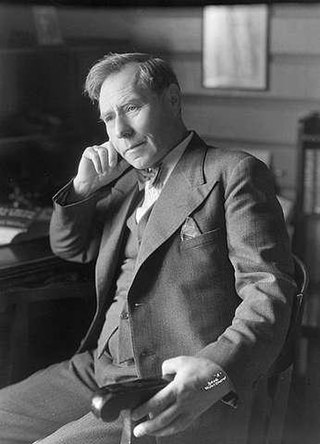Top Qs
Timeline
Chat
Perspective
Olav Duun
Norwegian writer (1876–1939) From Wikipedia, the free encyclopedia
Remove ads
Olav Duun (21 November 1876 – 13 September 1939) was a writer of Norwegian fiction. He is generally recognized to be one of the more outstanding writers in Norwegian literature. He was nominated for the Nobel Prize in Literature twenty-four times in fourteen years,[1] and once lacked only one vote to receive the prize.[2][3]


Remove ads
Early life
Duun was born in the traditional district of Outer Namdalen,[4] on the island of Jøa which is located in the Namsenfjorden in Fosnes Municipality in Nord-Trøndelag county, Norway. His parents were Johannes Antonius Duun and Ellen (Fossum) Duun. Olav Duun was born Ole Johannesen Raaby. Duun was the oldest in a family of eight siblings. During his years as a boy his family lived at several farms on the island, the last one being Duun. He adopted the last name Duun when he left the island to start his training as a teacher.
He attended the state school at Trondheim. In 1901, Duun took a position as a school teacher in Levanger Municipality in Nord-Trøndelag county, Norway.
Remove ads
After accepting a post as a teacher
He completed the graduate teacher examination in 1904. In 1908, he was hired by the Ramberg school at Botne Municipality in Vestfold county, where he combined teaching profession with writing poetry. He worked as a teacher in Holmestrand Municipality until 1927. At the age of fifty, he retired in order to devote his time to writing.[5]
Writing career
Summarize
Perspective
Duun was known as one of the outstanding[citation needed] writers of 20th-century Norwegian fiction. He stands as a remarkable[citation needed] synthesis of the Norwegian folk spirit and the European cultural form[clarification needed]. Duun wrote in Landsmål, an amalgam of peasant dialects that developed into Nynorsk, one of the official languages of Norway. In the period 1907-38 he published 25 novels, four short story collections ("sagas" was his own genre term) and two children's books. Many of his books incorporate the dialects of his subjects: peasants, fishermen and farmers. His novels analyze the psychological and spiritual characteristics of rural, peasant life. Contact with family traditions is a strength for the heroes in his historical novels, and awareness of those who have lived before, and the strength of their actions can help modern people through crises.
The most notable works are his six volume, The People of Juvik, which deals with four generations of a family of peasant landowners. This work was translated into English and published as: The Trough of the Waves (1930), The Blind Man (1931), The Big Wedding (1932), Odin in Fairyland (1932), Odin Grows Up (1934) and Storm (1935).[6]
Olav Duun was nominated for the Nobel Prize in Literature twenty-four times between 1924 and 1939.[7] Certain about a rumour that Duun was going to be awarded the prize in 1926, the Norwegian newspaper Aftenposten wrongly announced Duun as the winner of the Nobel Prize in Literature on their front page on 11 November 1926 before the Swedish Academy's announcement of George Bernard Shaw as the winner later that day, which was a publication scandal in Norway. Duun lost out to Shaw with just one vote.[8][9]
Legacy
Former residence, now a library related to his works
Olav and Emma Duun's House (Olav og Emma Duuns Hus) is the former residence of Olav Duun and his wife Emma, at Ramberg in Holmestrand Municipality. There is a library containing manuscripts, letters, and other things related to the writing career of Olav Duun. The first floor is at the disposal of recipients of the Duun Scholarship. In the garden, a memorial park has been constructed containing commemorative rocks with lyrical quotes from Olav Duun’s poems.[10] The address is 20 Olav Duun Street.
Remove ads
Bibliography
- 1907: Oddballs and Other People (Løglege skruvar og anna folk)
- 1908: Marjane
- 1909: Crosswise (På tvert)
- 1910: The Slope by Nøkk Lake (Nøkksjøliga)
- 1911: Old Soil (Gamal jord)
- 1912: Hilder Island (Hilderøya), Storbåten
- 1913: Sigyn, Sommareventyr
- 1914: Three Friends (Tre venner)
- 1915: Harald
- 1916: Good Conscience (Det gode samvite)
- 1917: At Heather Island (På Lyngsøya)
- 1918-23: The People of Juvik (Juvikfolket)
- 1918: The Trough of the Waves (Juvikingar)
- 1919: The Blind Man (I Blinda)
- 1920: The Big Wedding (Storbybryllope)
- 1921: Odin in Fairyland (I eventyret)
- 1922: Odin Grows Up (I ungdommen)
- 1923: The Storm (I stormen)
- 1924: Blind-Anders
- 1925: Straumen og evja
- 1927: Olsøygutane
- 1928: Carolus Magnus
- 1929: Fellow Man (Medmenneske)
- 1930: On the Road and Getting Lost (Vegar og villstig)
- 1931: Ragnhild
- 1932: A Reputation Left Behind (Ettermæle)
- 1933: The Final Year of Life (Siste leveåre)
- 1935: God Smiles (Gud smiler)
- 1936: The Present Age (Samtid)
- 1938: Floodtide of Fate (Menneske og maktene)
Remove ads
Awards
- 1934 - Gyldendal's Endowment (initial award of this prize)
- 1935 - Henrik Steffens Prize (initial award of this prize)
References
Further reading
External links
Wikiwand - on
Seamless Wikipedia browsing. On steroids.
Remove ads
